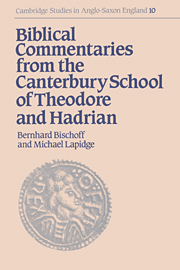Book contents
- Frontmatter
- Contents
- Preface
- List of abbreviations
- 1 Introduction
- 2 Archbishop Theodore
- 3 Abbot Hadrian
- 4 Theodore and Hadrian in England
- 5 The sources of the Canterbury biblical commentaries
- 6 The nature of the Canterbury biblical commentaries
- 7 The manuscripts
- Texts and translations
- Commentary to the texts
- Appendix I Additional manuscript witnesses to the Milan biblical commentaries
- Appendix II Two metrological treatises from the school of Canterbury
- Fig. 1 Cilicia and Syria
- Fig. 2 Constantinople in the seventh century
- Fig. 3 Churches and monasteries of seventh-century Rome
- Fig. 4 Cyrenaica and the Pentapolis
- Fig. 5 Campania and the Bay of Naples
- Fig. 6 Palestine
- Bibliography
- Index of Old English words quoted in the texts
- Index of Greek words quoted in the texts
- Index of names cited in the texts
- General index
1 - Introduction
Published online by Cambridge University Press: 08 January 2010
- Frontmatter
- Contents
- Preface
- List of abbreviations
- 1 Introduction
- 2 Archbishop Theodore
- 3 Abbot Hadrian
- 4 Theodore and Hadrian in England
- 5 The sources of the Canterbury biblical commentaries
- 6 The nature of the Canterbury biblical commentaries
- 7 The manuscripts
- Texts and translations
- Commentary to the texts
- Appendix I Additional manuscript witnesses to the Milan biblical commentaries
- Appendix II Two metrological treatises from the school of Canterbury
- Fig. 1 Cilicia and Syria
- Fig. 2 Constantinople in the seventh century
- Fig. 3 Churches and monasteries of seventh-century Rome
- Fig. 4 Cyrenaica and the Pentapolis
- Fig. 5 Campania and the Bay of Naples
- Fig. 6 Palestine
- Bibliography
- Index of Old English words quoted in the texts
- Index of Greek words quoted in the texts
- Index of names cited in the texts
- General index
Summary
The present volume brings into print for the first time a set of biblical commentaries on the Pentateuch and gospels which are preserved in their fullest form in an eleventh-century Italian manuscript now in Milan (Biblioteca Ambrosiana, M. 79 sup.), but of which extracts are preserved in a number of earlier manuscripts. One of these, a fragmentary manuscript now in Berlin (Staatsbibliothek der Stiftung Preussischer Kulturbesitz, Grimm 132, 2), of mid-eighth-century date, provides the absolute terminus ante quern for the composition of the commentaries; on the other hand, the fact that Isidore's Etymologiae are several times quoted verbatim in the commentaries shows that they were composed after c. 650, the approximate earliest time at which this work of Isidore (d. 636) was in circulation. The commentaries were composed, therefore, broadly between the mid-seventh and mid-eighth century. That they were composed in Anglo-Saxon England is clear not only from the various Old English words embedded in them, but also from the fact that biblical references to weights and measures are frequently explained in terms of Anglo-Saxon coinage. Most importantly, Theodore and Hadrian are often cited nominatim as authorities for particular interpretations, and the conjunction of these names in the context of a work composed in Anglo-Saxon England between c. 650 and c. 750 suggests that the authorities in question are none other than Theodore, archbishop of Canterbury (d. 690) and his companion Hadrian (d. 709), abbot of the monastery of SS Peter and Paul (later St Augustine's) in Canterbury.
- Type
- Chapter
- Information
- Publisher: Cambridge University PressPrint publication year: 1995

